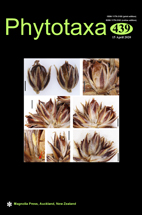Abstract
Among the ten species currently accepted in the genus Calliblepharis, the only representative in the Western Atlantic is C. occidentalis. The endemic Brazilian species C. jolyi was merged into Craspedocarpus, but its generic placement is unclear. Because some species superficially resemble flat Hypnea, our knowledge about the diversity and distribution of Calliblepharis could be incomplete. Therefore, to reassess species diversity of Calliblepharis in Brazil, we carried out an rbcL-based molecular survey of specimens collected along the Brazilian coast, including the type locality of C. jolyi (State of Espírito Santo). Molecular analysis of topotypes supported the reinstatement of Calliblepharis jolyi. This species was placed within Calliblepharis sensu lato in a fully supported clade with C. fimbriata, C. occidentalis, C. rammediorum and Calliblepharis sp. Calliblepharis jolyi is easily distinguished from its congeners by the presence of conspicuous lenticular thickenings. A new record of C. saidana, a species so far known only from the Indo-Pacific, was also revealed for the Atlantic Ocean. Samples collected in São Paulo were grouped with C. saidana from Japan (type locality) with rbcL intraspecific divergence of 0.8%. Taken together, our results provide a better understanding of flat Cystocloniaceae, focusing on Brazilian members and their affinities with other species. Our study call attention to the importance of a molecular approach in specimens from type localities, using information of the original descriptions to define their taxonomic status.

